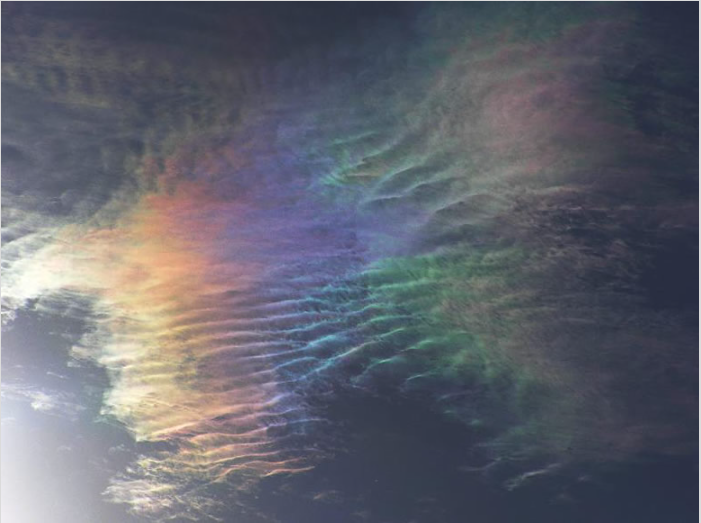Iridescent Clouds
Iridescent Clouds: Nature's Colorful Display in the Sky
Have you ever looked up at the sky and noticed a breathtaking display of vibrant colors within a cloud? If so, you may have witnessed a phenomenon known as iridescent clouds. These ethereal and captivating displays of color are a result of the interaction between sunlight and tiny water droplets or ice crystals within the clouds. While iridescent clouds are relatively rare, they can occur in various types of clouds and under specific atmospheric conditions.
How Do Iridescent Clouds Form?
Iridescent clouds form when sunlight interacts with small water droplets or ice crystals within the cloud. As sunlight passes through these particles, it undergoes a process called diffraction, where the light waves are scattered and separated into their component colors. This scattering of light creates a stunning display of colors similar to those seen in a rainbow.
Types of Iridescent Clouds
Iridescent clouds can manifest in different forms, each with its own unique characteristics. Some common types of iridescent clouds include:
-
Cirrocumulus Iridescence: These iridescent clouds often appear as patches or ripples of color against a backdrop of wispy cirrocumulus clouds. The delicate and intricate patterns created by the diffracted light can be truly mesmerizing.
-
Altocumulus Iridescence: Altocumulus clouds are mid-level clouds that can also exhibit iridescence. When sunlight interacts with the water droplets or ice crystals within altocumulus clouds, it can create stunning displays of color that resemble brush strokes across the sky.
-
Stratocumulus Iridescence: Stratocumulus clouds, which typically appear as low-level layers, can also produce iridescence under the right conditions. The diffraction of sunlight within these clouds can result in subtle bands of color, adding a touch of magic to the sky.
Factors Influencing Iridescence
While the formation of iridescent clouds primarily depends on the interaction between sunlight and cloud particles, several factors can influence the intensity and visibility of the colors observed. These factors include:
-
Cloud Thickness: The thickness of the cloud layer can affect the amount of sunlight that reaches the water droplets or ice crystals within the cloud. Thicker clouds may produce more pronounced iridescence.
-
Particle Size: The size of the water droplets or ice crystals within the cloud plays a crucial role in determining the colors observed. Smaller particles tend to produce more vibrant and well-defined colors.
-
Sun Angle: The angle at which sunlight interacts with the cloud particles affects the visibility of iridescence. The most intense and vivid displays are often observed when the sun is low on the horizon.
The Ephemeral Nature of Iridescent Clouds
Iridescent clouds are known for their fleeting nature. They can appear and disappear quickly, making them a captivating but elusive sight to behold. The ever-changing atmospheric conditions and the movement of the cloud layers contribute to the transient nature of iridescence.
Similar Atmospheric Phenomena
While iridescent clouds are a remarkable sight, there are other atmospheric phenomena that share similarities in terms of their visual appearance. These include:
-
Glory: A glory is a circular rainbow-like phenomenon that appears as a set of colored rings around the shadow of an observer when sunlight interacts with water droplets or small ice crystals in mist or fog.
-
Corona: A corona is a circular or elliptical optical phenomenon that appears as a series of colored rings around the sun or moon. It is caused by diffraction and interference of light by water droplets or ice crystals in thin clouds.
The Beauty and Wonder of Iridescent Clouds
Iridescent clouds are a testament to the beauty and complexity of our atmosphere. Their vivid colors and ephemeral nature remind us of the ever-changing and dynamic nature of the world around us. While they may be rare to witness, the sight of iridescent clouds is sure to leave a lasting impression and inspire awe in anyone fortunate enough to observe them. So, next time you find yourself gazing at the sky, keep an eye out for these stunning displays of nature's artistry.

Another view of Shannon Story's iridescent clouds of Dec 4, 2005. First image.
Iridescent clouds can evolve quickly.
Image ©Shannon Story,
shown with permission
Note: this article has been automatically converted from the old site and may not appear as intended. You can find the original article here.
Reference Atmospheric Optics
If you use any of the definitions, information, or data presented on Atmospheric Optics, please copy the link or reference below to properly credit us as the reference source. Thank you!
-
<a href="https://atoptics.co.uk/blog/iridescent-clouds-4/">Iridescent Clouds</a>
-
"Iridescent Clouds". Atmospheric Optics. Accessed on December 19, 2024. https://atoptics.co.uk/blog/iridescent-clouds-4/.
-
"Iridescent Clouds". Atmospheric Optics, https://atoptics.co.uk/blog/iridescent-clouds-4/. Accessed 19 December, 2024
-
Iridescent Clouds. Atmospheric Optics. Retrieved from https://atoptics.co.uk/blog/iridescent-clouds-4/.